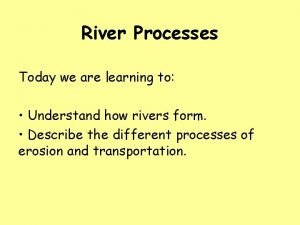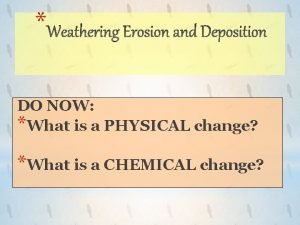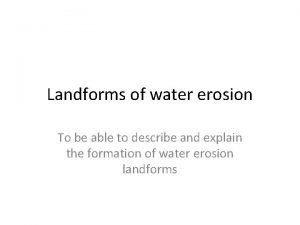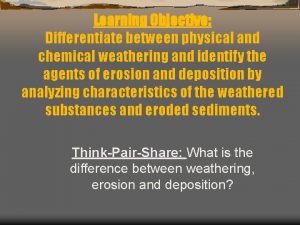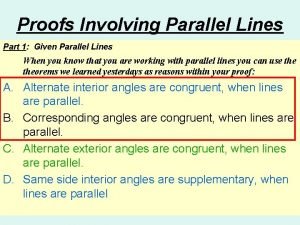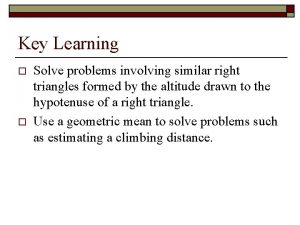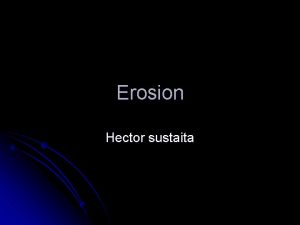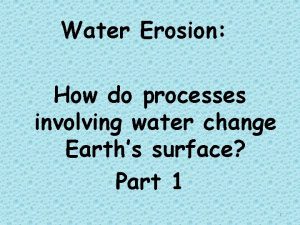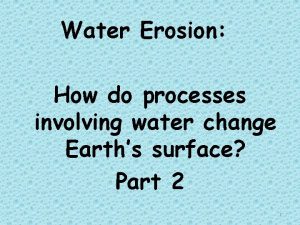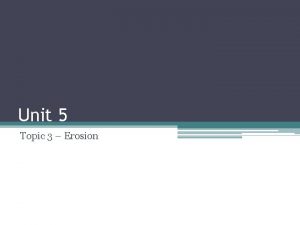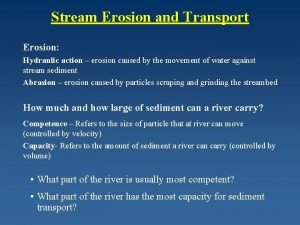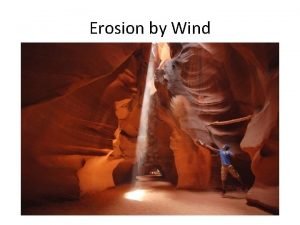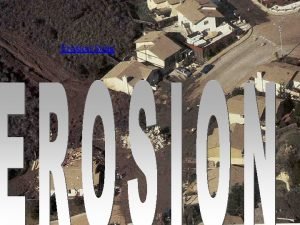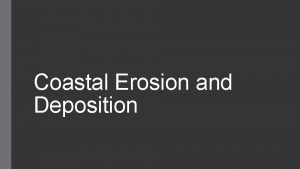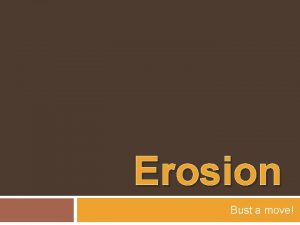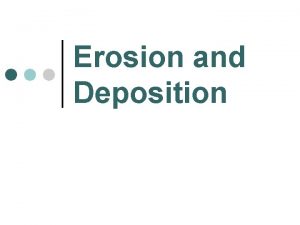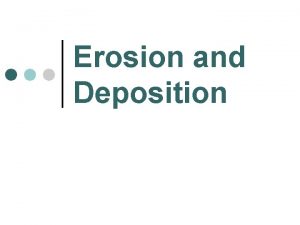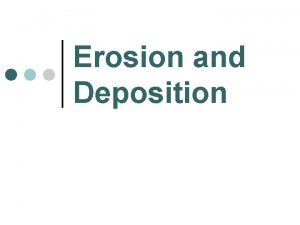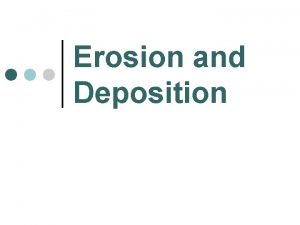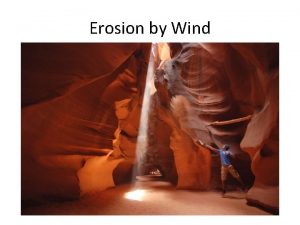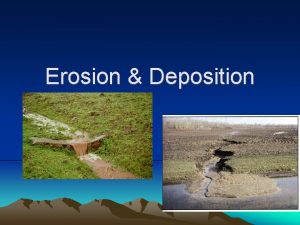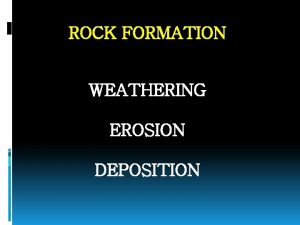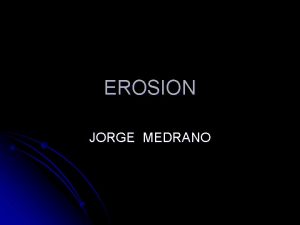Water Erosion How do processes involving water change
































- Slides: 32

Water Erosion: How do processes involving water change Earth’s surface? 1

What is the MAJOR agent of erosion that has shaped Earth’s land surface? 2

Moving water 3

Water moving over land’s surface is called runoff. 4

The amount of water runoff in an area depends on 5 main factors: 5

Factors that affect Runoff 1. The amount of rain an area receives. *More rain = more runoff 2. Vegetation - grasses, shrubs & trees reduce runoff. *More vegetation=less runoff 3. Type of soil - some soils absorb more water than others 4. Shape of the land – steep slopes have more run-off, which causes more erosion 5. How people use the land – parking lots & crop removal increase run-off. 6

Runoff overtime: How does runoff over time affect the land water? 7

Rills & Gullies As runoff travels across the soil, rills form. Rills are tiny grooves in the soil that grow larger forming gullies. A gully is a large groove or channel in the soil that carries runoff after a storm. It moves soil & rocks. Rills & Gullies only contain water after it rains. 8

Streams & Rivers Gullies join together to form a larger channel called a stream. Water continuously flows here and rarely dries up. Small streams may be called creeks or brooks. Small streams flow together to form a large stream called a river. 9

10

Rill, Rill erosion at a construction site. Image by M. Mamo, Labels added by UNL Gully, Stream Gully erosion in a pasture. Image by NRCS Stream 11

Tributaries Streams grow together by getting water from tributaries. A tributary is a stream or river that flows into a larger river. An example: The Missouri & Ohio rivers are tributaries of the Mississippi river. 12

Rivers: * cause erosion and create valleys, waterfalls, flood plains, meanders and oxbow lakes. *form on steep mountain slopes. 13

How do they flow? Quickly and follow a narrow path How do they erode? Rapidly The result is that rivers form deep, V-shaped valleys. 14

Valleys http: //www. google. com/imgres? imgurl=http: //cgz. e 2 bn. net/e 2 bn/leas/c 99/schools/cgz/accounts/staff/r chambers/Geo. Bytes%2520 GCSE%2520 Blog%2520 Resources/Images/Rivers/Vshapedvalley. jpg&imgrefurl=http: //geobytesgcse. blogspot. com/2006/11/upper-course-of-river-v-shapedvalleys. html&usg=__Hp 8 C 8 YOunb. Wz. Jy 9 E 7 kb. Qc. Oi. URz. A=&h=308&w=411&sz=47&hl=en&start=0&zoom=1 &tbnid=giw. F 1 Fpp. YFy 8 z. M: &tbnh=116&tbnw=154&ei=kk 2 Tf. Kt. EMH 68 Ab. I__2 t. BA&prev=/images%3 Fq%3 Dvshaped%2 Bvalley%26 um%3 D 1%26 hl%3 Den%26 sa%3 DN%26 biw%3 D 1280%26 bih%3 D 531%26 tbs%3 Disch: 10%2 C 35&um=1&itbs=1&iact=hc&vpx=247&vpy=77&dur=701&hovh=194&hovw=259&tx=161&ty=116&o ei=g 0 k 2 Tb. G 1 L 4 T 58 Aa 8 n. OC 7 Aw&esq=12&page=1&ndsp=22&ved=1 t: 429, r: 1, s: 0&biw=1280&bih=531 http: //images. travelpod. com/users/theboy_picot/3. 1149265860. 580 x-nice-v-shapedvalley. jpg 15

Features of rivers: What features are formed by erosion along a river? 16

Waterfalls Occur where? Where a river meets an area of hard & slowly eroding rock Then flows over softer rock downstream. How does softer rock erode? The softer rock erodes away faster. What results from this erosion? A waterfall develops. 17

Waterfalls at the Plitvicka Jezera National Park in Croatia Minnehaha Falls, Minneapolis Minnesota http: //images. google. com/imgres? imgurl=http: //realestate-inminnesota. com/images/Minneapolis. jpg&imgrefurl=http: //realestate-inminnesota. com/&usg=__k. BYWa. Wcel. Jl. Cs. NAEDq 6 zr 8 e. LY=&h=599&w=800&sz=162&hl=en&start=5&um=1&tbnid=WO 5 G 4 j. C_r. IKDMM: &tbnh=107&tbnw=143&prev=/images%3 Fq%3 Dminnehaha%2 Bfalls, %2 B 18 mn%26 ndsp%3 D 18%26 hl%3 Den%26 sa%3 DG%26 um%3 D 1

Flood Plain What is a flood plain? A wide valley in which a river flows What happens to the land during a flood? The water in the river over flows its banks into this wide river valley area. 19

Flood Plain 20

Meanders What are meanders? Loop-like bends in the course of a river. Where & how do they occur? They occur as the outer bank of a river is eroded & deposits are dropped on the inner bank of the bend in a river. 21

Mississippi River Meanders http: //images. google. com/imgres? imgurl=http: //www. ecology. info/img/Mississippi. River. jpg&imgrefurl=http: //www. ecology. info/article. aspx%3 Fcid%3 D 12%26 id%3 D 10&usg=__B 9 Cvp. JJ 70 Ydm 7 HE 2 Lj. Hs 3 GW 76 Ec=&h=450&w=600&sz=57& hl=en&start=8&tbnid=Q 3 zaqd. FNmc 7 QVM: &tbnh=101&tbnw=135&prev=/images%3 Fq%3 Dmeanders%26 gbv%3 D 2%26 hl%3 Den%26 sa%3 DG 22

Oxbow Lakes What is an oxbow lake? A meander that has been cut-off from the river. They may form when a river floods as high water finds a straighter path downstream. As flood waters fall, sediments dam up the ends of the meander and a lake forms. 23

Oxbow Lakes http: //muller. lbl. gov/travel_photos/Amazon. Web. Pages-Images/1. jpg 24

Alluvial Fan • Where a stream flows out of a steep, narrow mountain valley, the stream suddenly become wider and shallower. The water slows down. The sediments continue moving creating a fan shape. 25

26

Delta • A river ends its journey when it flows into a still body of water, such as an ocean or a lake. Because the river water is no longer flowing downhill, the water slows down. At this point, the sediment in the water drops to the bottom. Sediment deposited where a river flows into an ocean or lake builds up a landform called a delta. • Deltas can be a variety of shapes. 27

Ground Water Erosion • Groundwater is the term geologists use for the underground water. Like running water on the surface, groundwater affects the shape of the land. • Groundwater can cause erosion through a process of chemical weathering. When water sinks into the ground, it combines with carbon dioxide to form a weak acid, called carbonic acid. 28

Carbonic Acid • Carbonic acid can break down limestone. • Groundwater containing carbonic acid flows into cracks in the limestone. The limestone changes chemically and is carried away in a solution of water. • This gradually hollows out pockets in the rock. Over time, these pockets develop into large holes underground, called caves or caverns. 29

Stalactites and Stalagmites • carbonic acid on limestone can also result in deposition. • Water containing carbonic acid and calcium from limestone drips from a caves roof. As the water evaporates, a deposit of calcite forms. • A deposit that hangs like an icicle from the roof of a cave is called a? • Stalactite. • Slow dripping builds up on the cave floor is called a? • Stalagmite. 30

Karst Topography • A landscape that is characterized by numerous caves, sinkholes, and underground streams. • Karst topography usually forms in regions of plentiful rainfall where bedrock consists of rock, such as limestone, that is easily dissolved. 31

Sink Hole 32
 Control measures of soil erosion slideshare
Control measures of soil erosion slideshare What are the processes involving river transportation
What are the processes involving river transportation Concurrent processes are processes that
Concurrent processes are processes that Water and water and water water
Water and water and water water Enagic founder
Enagic founder Is erosion a physical change
Is erosion a physical change Sheet water erosion
Sheet water erosion Butte diagram
Butte diagram Explain how water erosion by groundwater can form a cave.
Explain how water erosion by groundwater can form a cave. Differentiate between physical and chemical weathering
Differentiate between physical and chemical weathering Examples of physical changes
Examples of physical changes Physical changes
Physical changes Absolute change and relative change formula
Absolute change and relative change formula What is integers in maths
What is integers in maths Difference between chemical and physical change
Difference between chemical and physical change Quantity supplied vs supply
Quantity supplied vs supply Supply and demand curve shifts
Supply and demand curve shifts Reactive change is change that
Reactive change is change that Physical change
Physical change Spare change physical versus chemical change
Spare change physical versus chemical change Rocks change due to temperature and pressure change
Rocks change due to temperature and pressure change Whats the difference between physical and chemical changes
Whats the difference between physical and chemical changes How does a physical change differ from a chemical change
How does a physical change differ from a chemical change Chemical change baking
Chemical change baking First-order change
First-order change Chopping physical or chemical change
Chopping physical or chemical change Climate change 2014 mitigation of climate change
Climate change 2014 mitigation of climate change Describe two ways nick differs other guests party
Describe two ways nick differs other guests party A figure of speech involves an implied comparison
A figure of speech involves an implied comparison Solving problems involving temperature
Solving problems involving temperature Proofs involving parallel and perpendicular lines
Proofs involving parallel and perpendicular lines Word problems involving similar triangles
Word problems involving similar triangles 5-5 practice inequalities involving absolute value answers
5-5 practice inequalities involving absolute value answers

